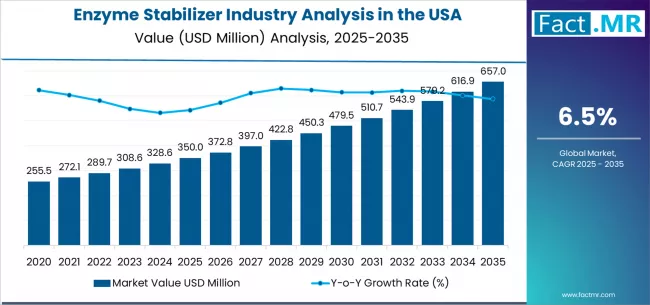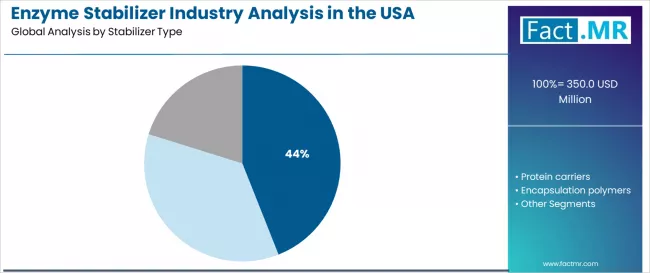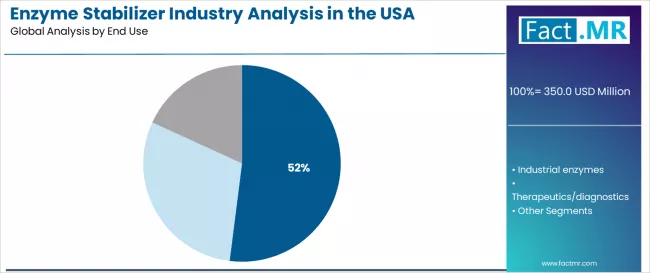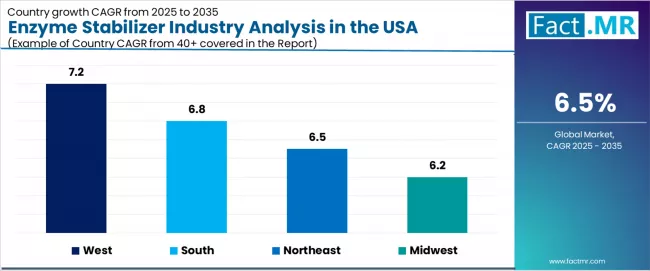Enzyme Stabilizer Industry Analysis in the USA
Enzyme Stabilizer Industry Analysis in the USA Size and Share Forecast Outlook 2025 to 2035
Enzyme stabilizer industry analysis in the USA is projected to grow from USD 350.0 million in 2025 to USD 657.0 million by 2035, at a CAGR of 6.5%. Polyols and Sugars will dominate with a 44.0% market share, while food and beverage will lead the end use segment with a 52.0% share.
Enzyme Stabilizer Industry Analysis in the USA 2025 to 2035
The demand for enzyme stabilizers in the USA is projected to grow from USD 350 million in 2025 to approximately USD 670 million by 2035, recording an absolute increase of USD 320 million over the forecast period. This translates into a total growth of 91.43%, with demand forecast to expand at a compound annual growth rate (CAGR) of 6.5% between 2025 and 2035.
The overall demand size is expected to grow by 1.91X during the same period, supported by increasing adoption of biotechnology preservation systems in food processing applications, rising emphasis on enzyme longevity solutions across industrial manufacturing, and growing focus on proven stabilization capabilities for specialized food and beverage and pharmaceutical biotechnology operations across the USA processing and wellness sectors.
Quick Stats for USA Enzyme Stabilizer Industry
- usa Enzyme Stabilizer Sales Value (2025): USD 350 million
- usa Enzyme Stabilizer Forecast Value (2035): USD 670 million
- usa Enzyme Stabilizer Forecast CAGR: 6.5%
- Leading Application in USA Enzyme Stabilizer Industry: Food and beverage (52.0%)
- Key Growth Regions in USA Enzyme Stabilizer Industry: West, Northeast, South, Midwest
- Regional Leadership: West holds the leading position in demand
- Key Players in USA Enzyme Stabilizer Industry: Novozymes A/S, DuPont de Nemours, Inc., DSM-Firmenich N.V., Kerry Group plc, Chr. Hansen Holding A/S, Archer-Daniels-Midland Company, AB Enzymes GmbH, Amano Enzyme Inc., Gnosis by Lesaffre

The food and beverage segment is projected to account for 52.0% of USA enzyme stabilizer demand in 2025. Food processing applications are widely used in the USA for commercial food manufacturing, premium enzyme formulation systems, and specialized biotechnology operations where preservation efficacy, processing reliability, and consistent enzyme performance remain essential for operational excellence and product quality standards.
The liquid formulations segment is expected to represent 58.0% of USA enzyme stabilizer demand in 2025. Food processors, biotechnology manufacturers, and industrial enzyme producers are fundamental to the enzyme stabilizer industry because they provide the volume demand, stringent preservation specifications, and operational consistency required for large-scale enzyme formulation development and commercial biotechnology production.
Between 2025 and 2030, demand for enzyme stabilizers in the USA is projected to expand from USD 350 million to USD 490 million, resulting in a value increase of USD 140 million, which represents 43.75% of the total forecast growth for the decade. This phase of growth will be shaped by increasing food processing infrastructure development, rising biotechnology adoption, and growing quality requirements across USA regions, particularly in areas where enzyme manufacturing expansion and preservation optimization initiatives are accelerating enzyme stabilizer adoption. Increasing integration of advanced stabilization technologies in food applications and growing adoption of quality verification systems continue to drive demand.
Biotechnology suppliers and food processors are expanding their production capabilities to address the growing complexity of modern enzyme formulation requirements and preservation standards, with USA operations leading investments in stabilization technology and enzyme activity verification systems.
From 2030 to 2035, demand is forecast to grow from USD 490 million to USD 670 million, adding another USD 180 million, which constitutes 56.25% of the overall ten-year expansion. This period is expected to be characterized by expansion of specialized biotechnology manufacturing facilities, development of advanced enzyme preservation applications, and implementation of comprehensive quality monitoring programs across different food processing and industrial enzyme sectors. The growing adoption of premium enzyme technologies and enhanced stabilization standards, particularly in major food processing centers and biotechnology operations, will drive demand for more sophisticated preservation solutions and validated quality systems.
Between 2020 and 2025, enzyme stabilizer demand in the USA experienced robust expansion, driven by increasing biotechnology volumes in food processing channels and growing awareness of preservation benefits for enzyme longevity and operational efficacy. The sector developed as food manufacturers and biotechnology brands, especially in major processing hubs, recognized the need for proven stabilization systems and effective preservation solutions to achieve operational objectives while meeting regulatory standards and quality expectations. Biotechnology suppliers and enzyme ingredient distributors began emphasizing supply chain optimization and stabilization verification to maintain competitive advantages and operational viability.
usa Enzyme Stabilizer Industry Key Takeaways
| Metric | Value |
|---|---|
| usa Enzyme Stabilizer Value (2025) | USD 350 million |
| usa Enzyme Stabilizer Forecast Value (2035) | USD 670 million |
| usa Enzyme Stabilizer Forecast CAGR (2025-2035) | 6.5% |
Why is the USA Enzyme Stabilizer Industry Growing?
Demand expansion is being supported by the accelerating emphasis on biotechnology preservation optimization and food processing transformation nationwide, with the USA maintaining its position as a premium food manufacturing and industrial enzyme leadership region, and the corresponding need for effective stabilization systems for enzyme applications, preservation compliance, and processing integration. Modern food facilities and biotechnology brands rely on enzyme stabilizer technologies to ensure enzyme performance, quality requirement fulfillment, and optimal pathway achievement toward comprehensive food processing and industrial biotechnology environments.
Advanced food processing and biotechnology requirements necessitate comprehensive preservation solutions including specialized enzyme capabilities, stabilization processing, and bioactive enhancement infrastructure to address diverse application needs and operational specifications.
The emerging enzyme stabilizer sector is establishing itself as a potent, biotechnology-driven ingredient for advanced food processing and industrial enzyme formulations within the country. Key to its success are standardized parameters that encompass enzyme activity preservation, stabilization efficiency, and final product stability, with these metrics increasingly guided by frameworks from organizations like the U.S. Pharmacopeia and the FDA's guidelines for food ingredients and enzyme processing, which help define the critical balance between preservation purity, enzyme longevity, and processing safety.
Segmental Analysis
The industry is segmented by stabilizer type, end use, format, and region. By stabilizer type, the industry is divided into polyols and sugars, protein carriers, and encapsulation polymers categories. In terms of end use, the industry is segmented into food and beverage, industrial enzymes, and therapeutics/diagnostics. By format, the industry covers liquid formulations and dry blends, with food and beverage representing a key growth and innovation hub for enzyme technologies. Regionally, the industry is divided into West, South, Midwest, and Northeast.
By Stabilizer Type, Polyols and Sugars Segment Accounts for 44.0% Share

The polyols and sugars segment is projected to account for 44.0% of USA enzyme stabilizer demand in 2025, making it the leading stabilizer type category across the sector. This dominance reflects the preservation performance requirements and formulation versatility needs of modern food processing systems for existing enzyme applications and biotechnology installations where stabilization performance is optimized through standardized enzyme capabilities and integrated manufacturing architecture.
In the USA, where substantial food processing infrastructure requires enzyme integration without complete formulation redesign, polyols and sugars platforms provide practical pathways for preservation enhancement while maintaining processing continuity. Continuous innovations are improving enzyme stabilization, preservation purity characteristics, and formulation integration parameters, enabling food processors to achieve high quality standards while maximizing manufacturing efficiency.
The segment's strong position is reinforced by the extensive existing food processing infrastructure requiring advanced preservation adoption and growing availability of enzyme stabilizer suppliers with proven quality experience.
- Formulation compatibility and existing product integration make polyols and sugars platforms the preferred stabilizer type for enhancing operating food facilities and biotechnology operations.
- Preservation reliability and performance demonstration track records are enhancing processor confidence and enzyme viability across large-scale adoption initiatives.
By End Use, Food and Beverage Segment Accounts for 52.0% Share

Food and beverage applications are expected to represent 52.0% of USA enzyme stabilizer demand in 2025, highlighting the critical importance of enzyme preservation formulations requiring comprehensive stabilization solutions. Food products including processed foods, beverages, and specialty formulations generate consistent demand for enzyme stabilizer systems that are preservation and economically favorable for food processing applications.
The segment benefits from stabilization characteristics that often provide superior enzyme effectiveness compared to alternative preservation ingredients, reducing formulation complexity and potential enzyme degradation. Food and beverage applications also access enhanced processing optimization through proven preservation performance that improves product benefits and quality satisfaction.
In the USA, where major food operations represent substantial portions of processing infrastructure, product excellence requires enzyme stabilizer integration across diverse food environments. In West and Northeast regions, where food manufacturing infrastructure concentrations are significant, enzyme stabilizer demand is elevated by emphasis on maintaining preservation excellence while achieving product differentiation targets.
- Product differentiation and favorable preservation economics make this the largest application segment for enzyme stabilizer technologies.
- Processor demand for proven, reliable preservation actives drives consistent demand across major food manufacturers, biotechnology brands, and industrial enzyme specialists.
What are the Drivers, Restraints, and Key Trends in the USA Enzyme Stabilizer Industry?
usa enzyme stabilizer demand is advancing steadily due to increasing demand for proven preservation ingredients and growing recognition of its stabilization necessity for modern food processing and biotechnology compliance, with the West region serving as a key driver of innovation and product development. The sector faces challenges including competition from alternative preservation ingredients, the need for specialized stabilization infrastructure development, and ongoing concerns regarding supply chain consistency and quality standardization.
Food processing consciousness expansion initiatives and biotechnology programs, particularly in the West and Northeast regions, continue to influence enzyme stabilizer selection and formulation timelines.
Expansion of Food Processing Development and Biotechnology Programs
The enhancement of processing standards, gaining particular significance through enzyme preservation trends and food facility expansion campaigns, is enabling enzyme stabilizer suppliers to achieve differentiation without prohibitive stabilization costs, providing predictable demand patterns through processor requirements and product preferences. Enhanced preservation standards offering substantial opportunities for enzyme stabilizer systems and integrated applications provide foundational dynamics while allowing suppliers to secure food manufacturing agreements and biotechnology partnerships.
These trends are particularly valuable for first-mover suppliers and premium quality development that require substantial production investments without immediate cost advantages.
Deployment of Quality Monitoring Technologies and Stabilization Systems
Modern enzyme stabilizer suppliers and food processors are establishing advanced quality control networks and centralized stabilization facilities that improve operational efficiency through system standardization and enzyme analytics. Integration of testing systems, high-precision monitoring technology, and coordinated quality management enables more efficient preservation production across multiple processing regions.
Advanced stabilization concepts also support next-generation food applications including specialized preservation performance tracking, enzyme efficacy optimization, and regional distribution networks that optimize system-level economics while enabling comprehensive quality monitoring across food regions, with USA developments increasingly adopting collaborative processing models to reduce individual processor costs and accelerate adoption.
Development of Advanced Stabilization Methods and Preservation Technologies
The expansion of advanced stabilization technologies, processing innovation, and high-performance preservation solutions is driving demand for enzyme stabilizers with enhanced preservation performance and specialized application capabilities. These advanced applications require innovative stabilization platforms with precise composition control and exceptional enzyme reliability that exceed traditional preservation requirements, creating premium segments with differentiated performance propositions. Processors are investing in production capabilities and stabilization advancement to serve emerging food applications while supporting innovation in advanced enzyme stabilizer production and biotechnology sectors.
Analysis of USA Enzyme Stabilizer Demand by Key Region

| Region | CAGR (2025 to 2035) |
|---|---|
| West | 7.2% |
| South | 6.8% |
| Northeast | 6.5% |
| Midwest | 6.2% |
The USA enzyme stabilizer demand is witnessing robust growth, supported by rising food processing requirements, expanding biotechnology initiatives, and the deployment of advanced preservation technologies across regions. West leads the nation with a 7.2% CAGR, reflecting a strong food processing base, substantial biotechnology consciousness, and established enzyme stabilization facilities.
South follows with a 6.8% CAGR, driven by extensive food manufacturing facilities, favorable processing conditions, and a concentration of industrial enzyme operations that enhance application development. Northeast grows at 6.5%, supported by premium food brands and regional biotechnology research initiatives. Midwest demonstrates growth at 6.2%, as food processing expansion and enzyme efficiency opportunities increasingly drive enzyme stabilizer deployment.
West Leads National Growth with Food Processing and Biotechnology Applications

Demand for enzyme stabilizers in the West is projected to exhibit exceptional growth with a CAGR of 7.2% through 2035, driven by a strong food processing base, substantial biotechnology consciousness creating premium preservation opportunities, and a concentration of enzyme stabilization advancement across California, Oregon, Washington and surrounding states.
As the dominant region with extensive food industry infrastructure and progressive processing policies, the West's emphasis on comprehensive preservation utilization excellence and enzyme leadership is creating significant demand for enzyme stabilizer systems with proven performance and reliable stabilization potential. Major food processors and biotechnology suppliers are establishing comprehensive product development programs to support infrastructure advancement and premium ingredient deployment across diverse applications.
- Food processing base and operational preservation capabilities are requiring comprehensive quality management strategies and stabilization solutions, driving demand for enzyme stabilizer systems with demonstrated preservation performance capabilities and permanent enzyme assurance throughout diverse food operations.
- Food industry ecosystem strength and innovation capital availability are supporting the deployment of next-generation stabilization technologies and novel application pathways that enhance product viability, reduce formulation costs, and create new opportunities across high-performance and processing applications, positioning the West as a national enzyme stabilizer leadership region.
South Demonstrates Strong Potential with Food Manufacturing Infrastructure
Demand for enzyme stabilizers in the South is expanding at a CAGR of 6.8%, supported by extensive food manufacturing facilities including large-scale processing systems, industrial enzyme applications, and biotechnology operations generating concentrated demand favorable for preservation systems. The region's operational characteristics, featuring substantial food processing infrastructure and enzyme requirements ideal for stabilization integration, provide operational advantages.
Processing expertise concentrated in Texas and regional food corridors facilitates application development and quality management. Enzyme stabilizer suppliers and processors are implementing comprehensive efficiency strategies to serve expanding food-focused requirements throughout the South.
- Food processing concentration and favorable application economics are creating opportunities for specialized enzyme stabilizer suppliers that can integrate preservation systems with existing manufacturing operations.
- Processor positioning and biotechnology awareness are building regional competitive advantages in food applications, enabling comprehensive efficiency development and processor cluster enhancement that meets preservation targets while accessing performance pricing opportunities.
Northeast Shows Progressive Adoption with Premium Food Infrastructure
Demand for enzyme stabilizers in the Northeast is advancing at a CAGR of 6.5%, supported by expanding premium food brands, regional biotechnology research development, and growing emphasis on preservation solutions across the region.
Food infrastructure modernization and research facility expansion are driving consideration of enzyme stabilizer systems as preservation enhancement pathways. Food brands and biotechnology suppliers are developing regional capabilities to support emerging processing deployment requirements.
- Premium food brand concentration and operational diversification are creating economic drivers for preservation technologies and enzyme stabilizer deployment across biotechnology and processing facilities seeking competitive differentiation pathways.
- Regional research cooperation and coordinated product development are establishing consistent quality environments and shared operational infrastructure that support multi-state food projects throughout Northeast processing operations.
Midwest Maintains Steady Growth with Food Processing Expansion
Demand for enzyme stabilizers in the Midwest is growing at a CAGR of 6.2%, driven by expanding food operations from processing facilities, industrial enzyme operations, and regional biotechnology operations requiring preservation pathways.
The region's food processing base, supporting critical manufacturing operations, is increasingly adopting enzyme stabilizer technologies to maintain competitiveness while meeting preservation expectations. Processors and enzyme stabilizer suppliers are investing in production systems and regional supply infrastructure to address growing quality management requirements.
- Food processing modernization imperatives and operational competitiveness concerns are facilitating the adoption of enzyme stabilizer technologies that enable continued operations while achieving preservation enhancement across food operations, industrial enzyme processing, and biotechnology facilities.
- Processing diversification opportunities including regional brand development and facility utilization for enhanced enzyme environments are creating unique regional advantages and diversified application types throughout Midwest food operations.
Competitive Landscape of USA Enzyme Stabilizer Demand

usa enzyme stabilizer industry is witnessing stiff competition among specialized biotechnology processors, food ingredient companies, and integrated preservation solution providers, with major ingredient distributors maintaining significant influence through sourcing resources and formulation development capabilities. Companies are investing in stabilization advancement, processing infrastructure optimization, quality verification network structures, and comprehensive supply chain services to deliver effective, potent, and standardized preservation solutions across USA food processing and biotechnology applications.
Strategic partnerships, stabilization innovation development, and first-mover formulation execution are central to strengthening competitive positioning and presence across enzyme-grade, premium-quality, and commercial-scale preservation applications.
Novozymes A/S leads with a 15.20% share, offering comprehensive advanced enzyme stabilizer solutions including standardized preservation systems, biotechnology research backing, and distribution services with focus on food applications, enzyme reliability, and preservation optimization across USA operations. DuPont de Nemours, Inc., operating with extensive USA presence, provides integrated biotechnology solutions leveraging enzyme expertise, high-performance development, and quality management capabilities.
DSM-Firmenich N.V. delivers full-service enzyme stabilizer production including preservation development, processing optimization, and system integration serving USA and international food projects. Kerry Group plc emphasizes comprehensive ingredient solutions with integrated production capabilities, stabilization technology, and quality features leveraging food processing sector expertise. Chr. Hansen Holding A/S offers enzyme stabilizer application development and preservation optimization operations for food and biotechnology applications across USA operations.
Key Players in USA Enzyme Stabilizer Industry
- Novozymes A/S
- DuPont de Nemours, Inc.
- DSM-Firmenich N.V.
- Kerry Group plc
- Chr. Hansen Holding A/S
- Archer-Daniels-Midland Company
- AB Enzymes GmbH
- Amano Enzyme Inc.
- Gnosis by Lesaffre
Scope of the Report
| Item | Value |
|---|---|
| Quantitative Units | USD 350 Million |
| Stabilizer Type | Polyols and sugars, Protein carriers, Encapsulation polymers |
| End Use | Food and beverage, Industrial enzymes, Therapeutics/diagnostics |
| Format | Liquid formulations, Dry blends |
| Regions Covered | West, South, Midwest, Northeast |
| Key Companies | Novozymes A/S, DuPont de Nemours, Inc., DSM-Firmenich N.V., Kerry Group plc, Chr. Hansen Holding A/S, Archer-Daniels-Midland Company, AB Enzymes GmbH, Amano Enzyme Inc., Gnosis by Lesaffre |
| Additional Attributes | Sales by stabilizer type, end use, and format segment; regional demand trends across West, South, Midwest, Northeast; competitive landscape with established biotechnology suppliers and specialized stabilization technology developers; processor preferences for polyols and sugars vs. encapsulation polymers; integration with food formulation programs and preservation optimization policies (particularly advanced in West region) |
usa Enzyme Stabilizer Industry by Segments
-
Stabilizer Type :
- Polyols and sugars
- Protein carriers
- Encapsulation polymers
-
End Use :
- Food and beverage
- Industrial enzymes
- Therapeutics/diagnostics
-
Format :
- Liquid formulations
- Dry blends
-
Region :
- West
- South
- Midwest
- Northeast
Table of Content
- Executive Summary
- USA Market Outlook
- Demand to side Trends
- Supply to side Trends
- Technology Roadmap Analysis
- Analysis and Recommendations
- Market Overview
- Market Coverage / Taxonomy
- Market Definition / Scope / Limitations
- Market Background
- Market Dynamics
- Drivers
- Restraints
- Opportunity
- Trends
- Scenario Forecast
- Demand in Optimistic Scenario
- Demand in Likely Scenario
- Demand in Conservative Scenario
- Opportunity Map Analysis
- Product Life Cycle Analysis
- Supply Chain Analysis
- Investment Feasibility Matrix
- Value Chain Analysis
- PESTLE and Porter’s Analysis
- Regulatory Landscape
- Regional Parent Market Outlook
- Production and Consumption Statistics
- Import and Export Statistics
- Market Dynamics
- USA Market Analysis 2020 to 2024 and Forecast, 2025 to 2035
- Historical Market Size Value (USD Million) Analysis, 2020 to 2024
- Current and Future Market Size Value (USD Million) Projections, 2025 to 2035
- Y to o to Y Growth Trend Analysis
- Absolute $ Opportunity Analysis
- USA Market Pricing Analysis 2020 to 2024 and Forecast 2025 to 2035
- Introduction / Key Findings
- USA Market Analysis 2020 to 2024 and Forecast 2025 to 2035, By Region
- Introduction
- Historical Market Size Value (USD Million) Analysis By Region, 2020 to 2024
- Current Market Size Value (USD Million) Analysis and Forecast By Region, 2025 to 2035
- USA
- Market Attractiveness Analysis By Region
- USA Market Analysis 2020 to 2024 and Forecast 2025 to 2035, By Country
- Historical Market Size Value (USD Million) Trend Analysis By Market Taxonomy, 2020 to 2024
- Market Size Value (USD Million) Forecast By Market Taxonomy, 2025 to 2035
- By Country
- Market Attractiveness Analysis
- By Country
- Key Takeaways
- Market Structure Analysis
- Competition Dashboard
- Competition Benchmarking
- Market Share Analysis of Top Players
- By Regional
- Competition Analysis
- Competition Deep Dive
- Assumptions & Acronyms Used
- Research Methodology
List Of Table
- Table 1: USA Market Value (USD Million) Forecast by Region, 2020 to 2035
- Table 2: USA Market Value (USD Million) Forecast by Country, 2020 to 2035
List Of Figures
- Figure 1: USA Market Pricing Analysis
- Figure 2: USA Market Value (USD Million) Forecast 2020 to 2035
- Figure 3: USA Market Value (USD Million) Share and BPS Analysis by Region, 2025 and 2035
- Figure 4: USA Market Y to o to Y Growth Comparison by Region, 2025 to 2035
- Figure 5: USA Market Attractiveness Analysis by Region
- Figure 6: USA Market Incremental Dollar Opportunity, 2025 to 2035
- Figure 7: USA Market Value Share and BPS Analysis by Country, 2025 and 2035
- Figure 8: USA Market - Tier Structure Analysis
- Figure 9: USA Market - Company Share Analysis
- FAQs -
How big is the enzyme stabilizer industry analysis in the USA in 2025?
The global enzyme stabilizer industry analysis in the USA is estimated to be valued at USD 350.0 million in 2025.
What will be the size of enzyme stabilizer industry analysis in the USA in 2035?
The market size for the enzyme stabilizer industry analysis in the USA is projected to reach USD 657.0 million by 2035.
How much will be the enzyme stabilizer industry analysis in the USA growth between 2025 and 2035?
The enzyme stabilizer industry analysis in the USA is expected to grow at a 6.5% CAGR between 2025 and 2035.
What are the key product types in the enzyme stabilizer industry analysis in the USA?
The key product types in enzyme stabilizer industry analysis in the USA are polyols and sugars, protein carriers and encapsulation polymers.
Which end use segment to contribute significant share in the enzyme stabilizer industry analysis in the USA in 2025?
In terms of end use, food and beverage segment to command 52.0% share in the enzyme stabilizer industry analysis in the USA in 2025.